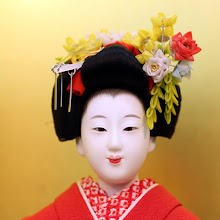Kabuki traces its origins back to 1603 when Okuni of Izumo began performing a new style of dance and drama in the dry riverbeds of Kyoto. The performances were done by women who portrayed both men and women and feature comic stories about everyday life. These performances gradually gained in popularity until Okuni was even asked to perform for the Imperial court.
With the increased popularity rival troupes quickly formed and the performances would be solely performed by women. Many of these performances became very suggestive and this only increased due to the fact that many of the troupe members were also prostitutes. In 1629 it was decided that women were degrading the art of the Kabuki and were therefore banned from Kabuki performances.
After this the performances were taken over by men who would cross-dress in order to take on the female roles. Strangely enough these performances required younger men with less masculine appearances in order to take on the female roles, but these performances were just as suggestive as the female versions. Many of these men were also available for prostitution as well. When the audiences began to get overly rowdy it was decided that roles involving young men, or men dressed as women should be banned, but both of these bans were rescinded in 1952.
Following these period Kabuki truly began to thrive and adopted a more formal structure. Conventional characters were developed and eventually professional playwrights of Kabuki entered the scene, the first of which was Chikamatsu Monzaemon. His most influential work was Sonezaki Shinju which was originally written for bunraku but was adopted for Kabuki. This work spawned many copycat versions, but the play’s nature (telling the story of lovers who committed suicide) was eventually banned by the government because it was believed to cause too many copycat suicides.
Today Kabuki remains the most popular of all the traditional styles of Japanese drama. There are a few theaters in the major cities as well as troupes that perform in the smaller cities and in the country. Today there are even troupes that include women in their cast and even a few troupes that have all women casts, just like the original kabuki troupes.

Is it possible to buy Kabuki background decoration ?
ReplyDeleteHi,what kind of decoration?
ReplyDeleteset used in the play is made by themselves, I believe. Let us know what kind a little bit more in detail.
Thanks for your comment.
Very informative, keep posting such good articles, it really helps to know about things.
ReplyDelete